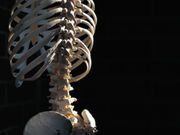High advanced glycation end product diet linked to faster bone aging changes in young female mice
TUESDAY, Feb. 6, 2018 (HealthDay News) — A high advanced glycation end product (H-AGE) diet is associated with decreased vertebral microstructure, mechanical behaviors, and fracture resistance in young female mice, according to a study published recently in the Journal of Bone and Mineral Research.
Svenja Illien-Jünger, Ph.D., from the Icahn School of Medicine at Mount Sinai in New York City, and colleagues examined whether high dietary AGE ingestion would diminish vertebral structure and function in a sex- and age-dependent manner. Female and male mice were fed low-AGE (L-AGE) or H-AGE diets for six and 18 months, and bone structure and function were measured.
The researchers observed an increase in AGE levels in serum and cortical vertebrae for 6-month-old H-AGE female mice, while for all animals, blood glucose and body weight remained normal. Six-month-old female mice had inferior vertebral trabecular structure with decreased bone mineral density (BMD) and bone volume fraction when fed an H-AGE diet. Six-month-old H-AGE females had functional deterioration with reduced shear and compression moduli, and maximum load to failure. H-AGE of both sexes had small but significant decreases in cortical BMD and thickness at 18 months, yet functional biomechanical behaviors were not distinguishable from other aging changes.
“We conclude that an H-AGE diet, without diabetic or overweight conditions, diminished vertebral microstructure, mechanical behaviors, and fracture resistance in young female mice in a manner suggesting accelerated bone aging,” the authors write.
Copyright © 2018 HealthDay. All rights reserved.








